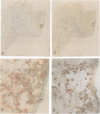Abstract
ATP binding cassette (ABC) transporters define a family of proteins with strong structural similarities conserved across evolution and devoted to the translocation of a variety of substrates across cell membranes. A few members of the family are known in mammals, but although all of them are medically relevant proteins, knowledge of their molecular function remains scanty. We report here a morphological and functional study of the recently identified mammalian ABC transporter, ABC1. Its expression during embryonic development correlates spatially and temporally with the areas of programmed cell death. More specifically, ABC1 is expressed in macrophages engaged in the engulfment and clearance of dead cells. Moreover, ABC1 transporter is required for engulfment since the ability of macrophages to ingest apoptotic bodies is severely impaired after antibody-mediated steric blockade of ABC1. A structural homologue of ABC1 has been identified in the Caenorhabditis elegans genome and maps close to the ced-7 locus. Since ced-7 phenotype is precisely defined by an imparied engulfment of cell corpses, it is tempting to surmise that ABC1 might be a mammalian homologue of ced-7.
Full text
PDF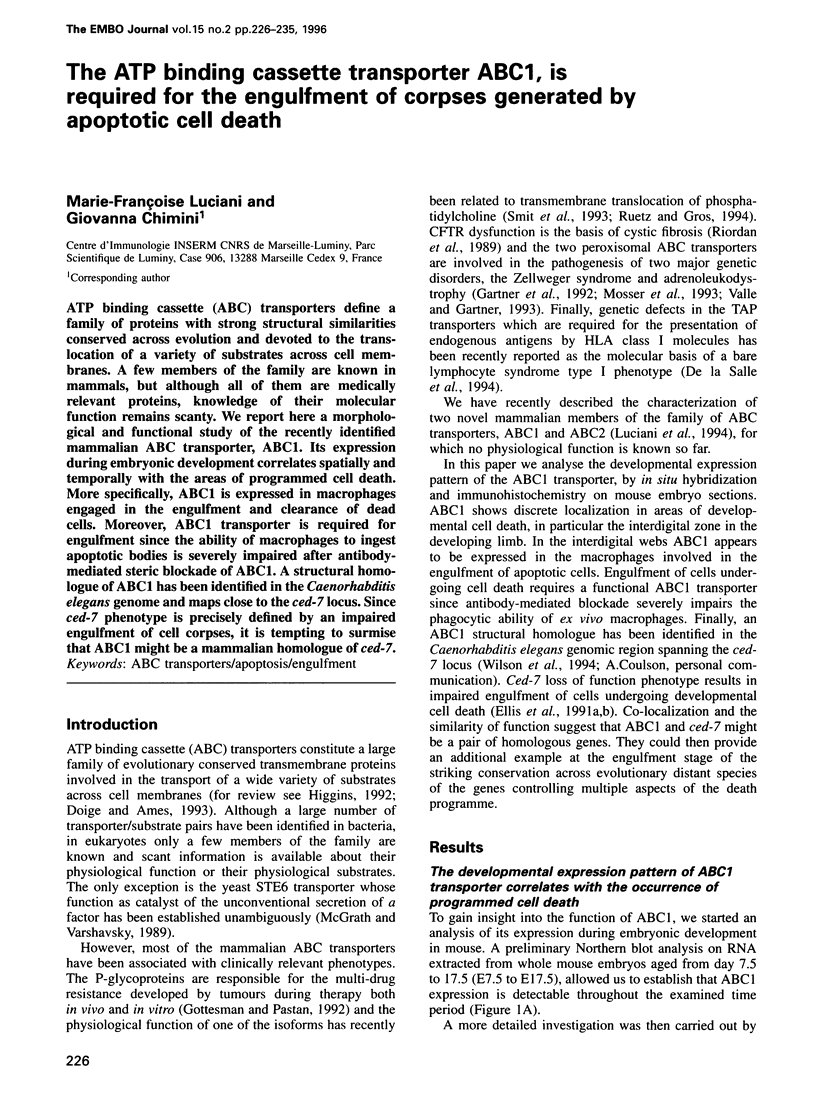
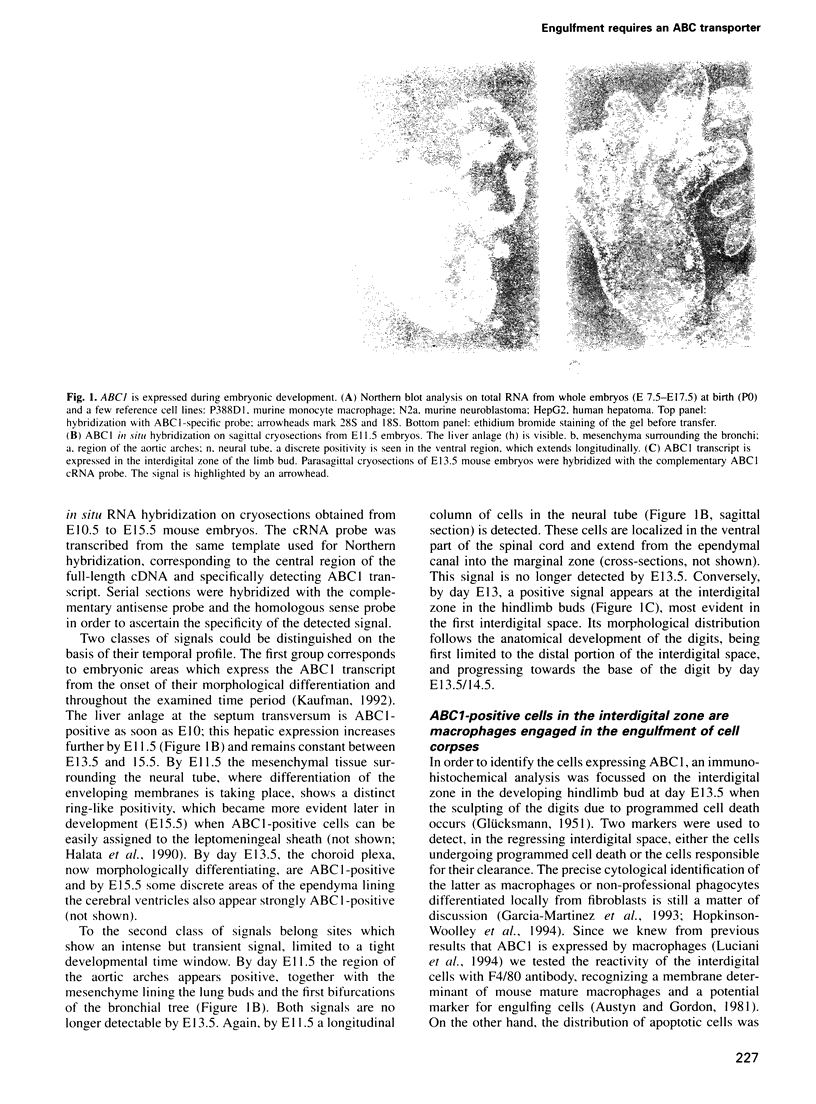
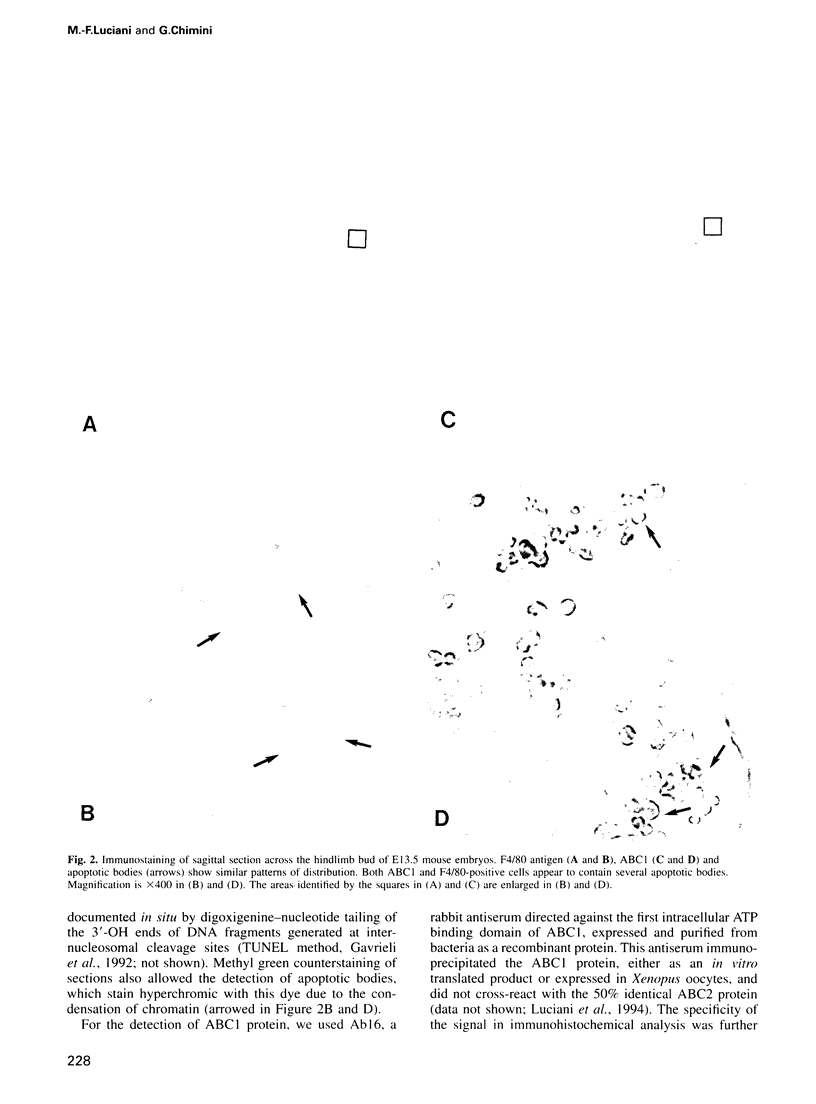
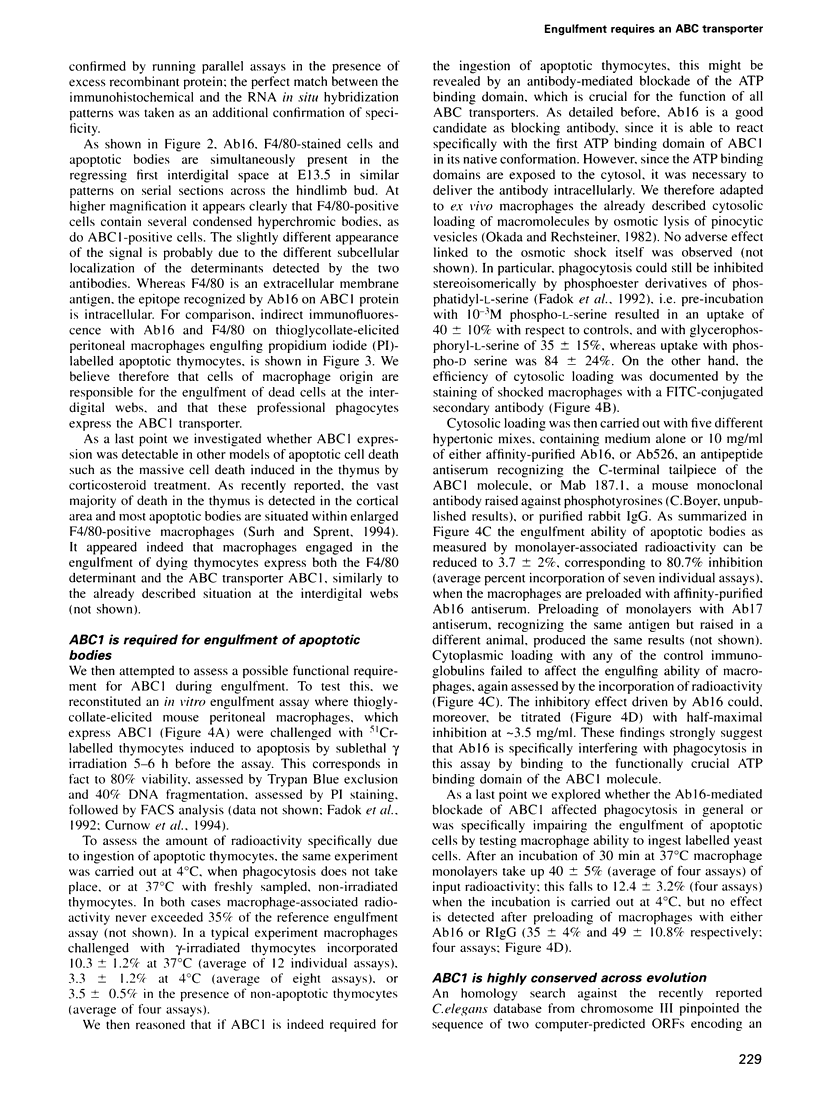
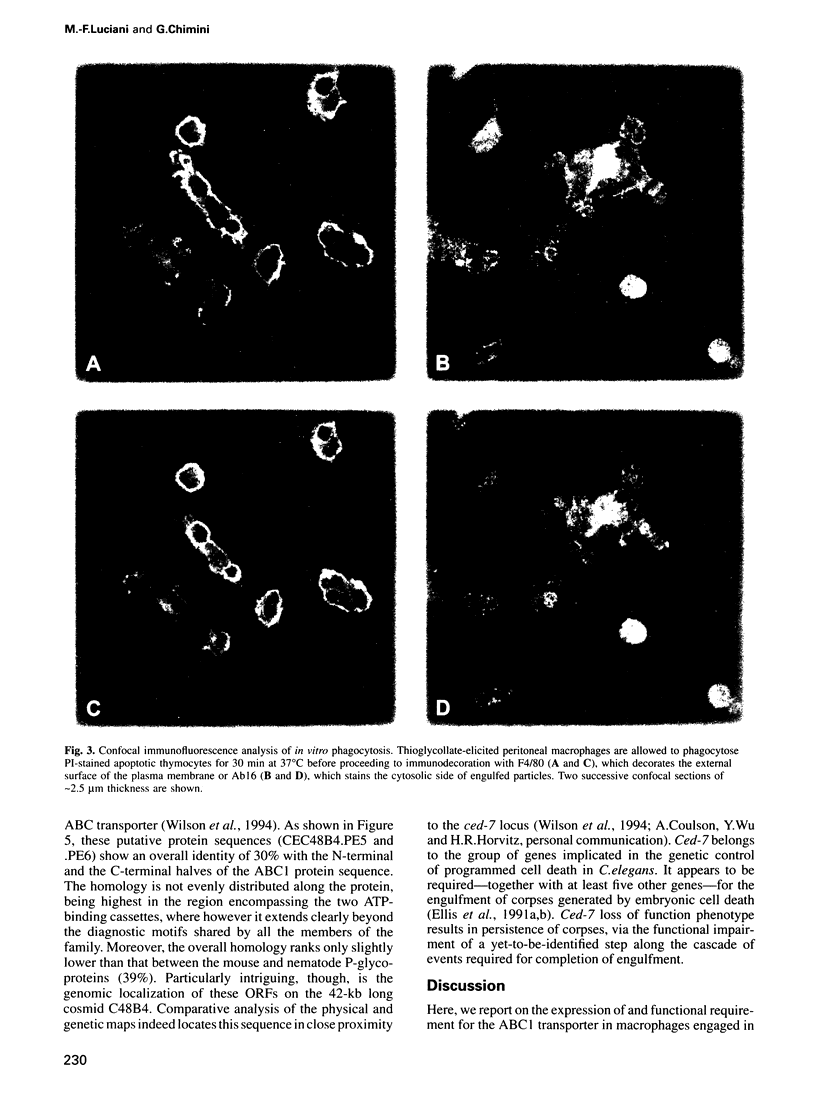
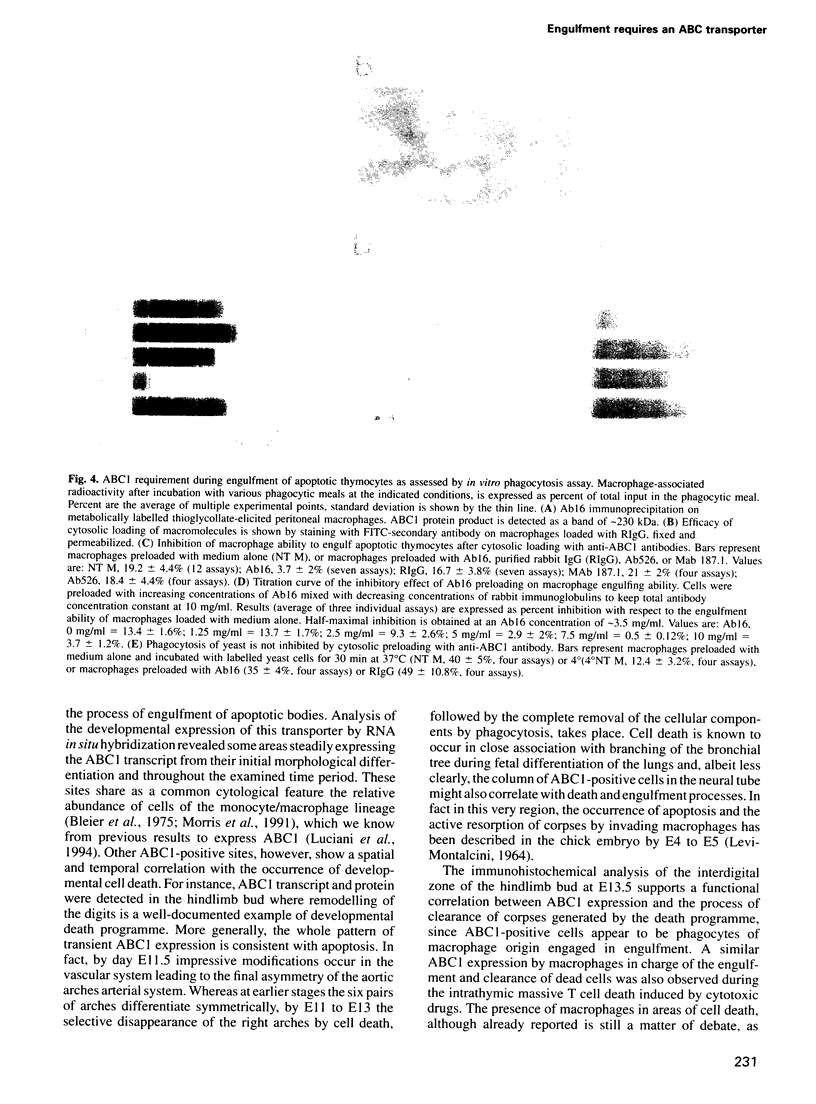
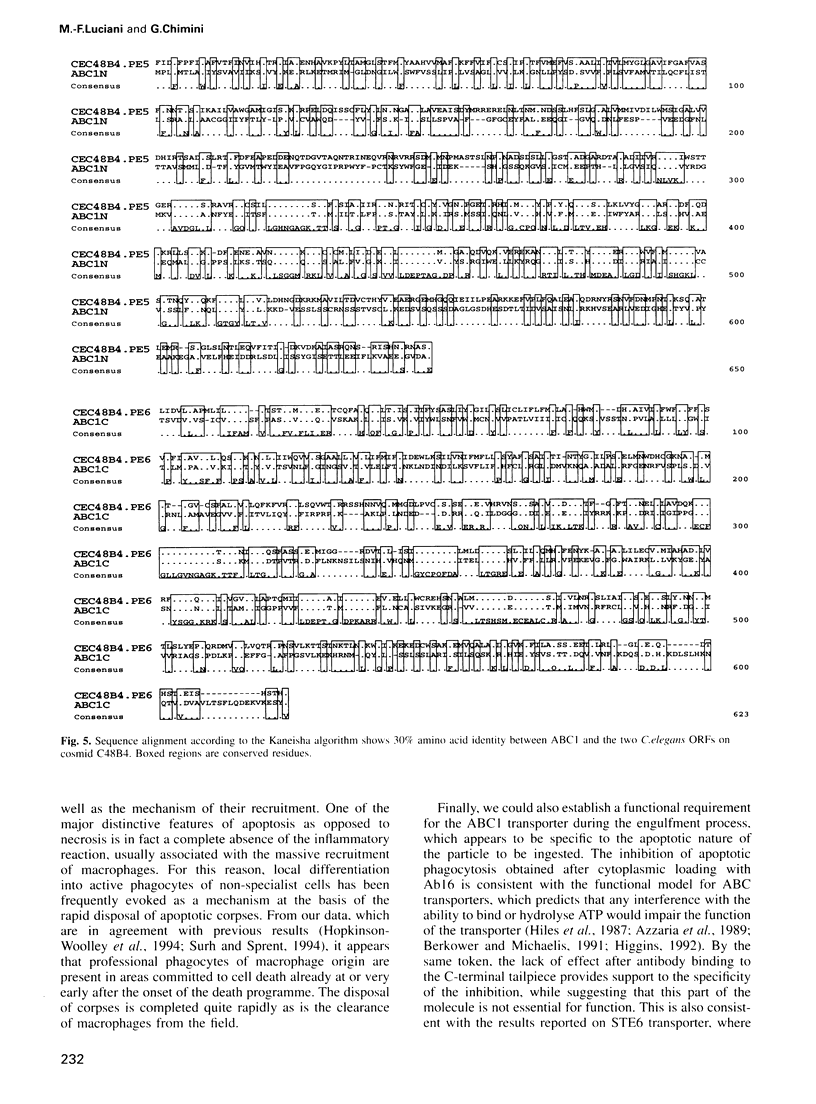
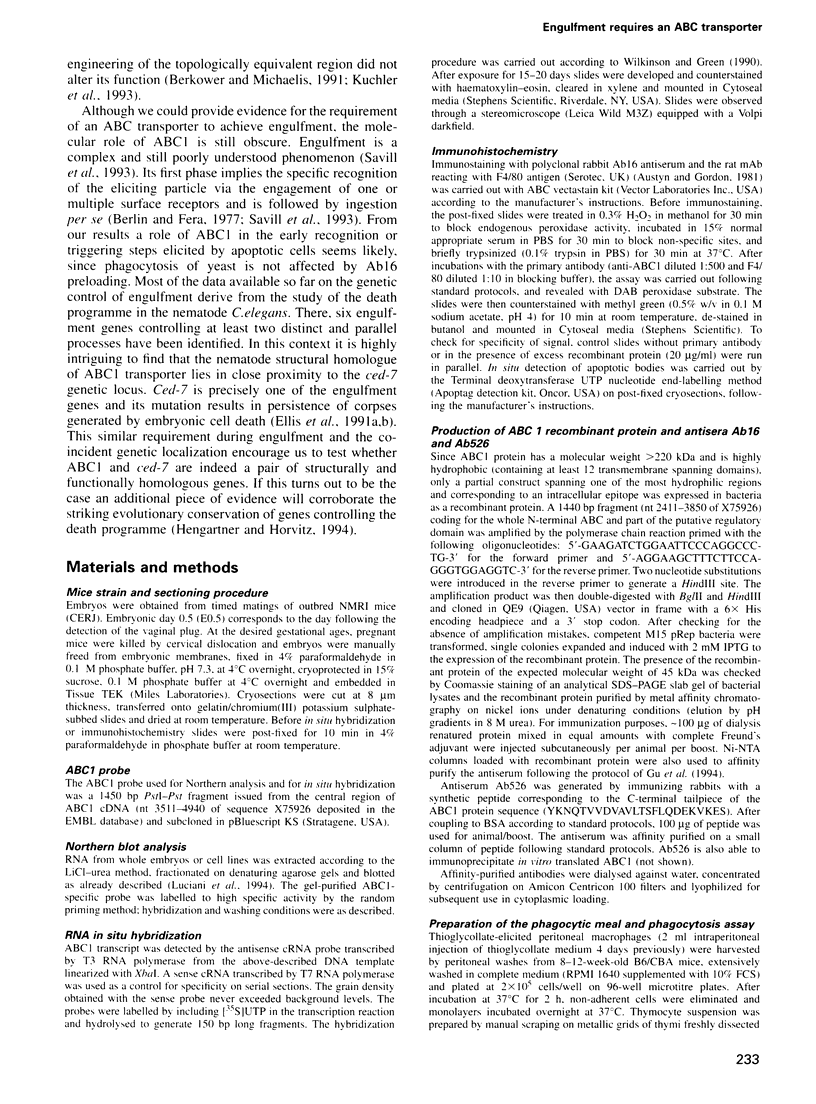
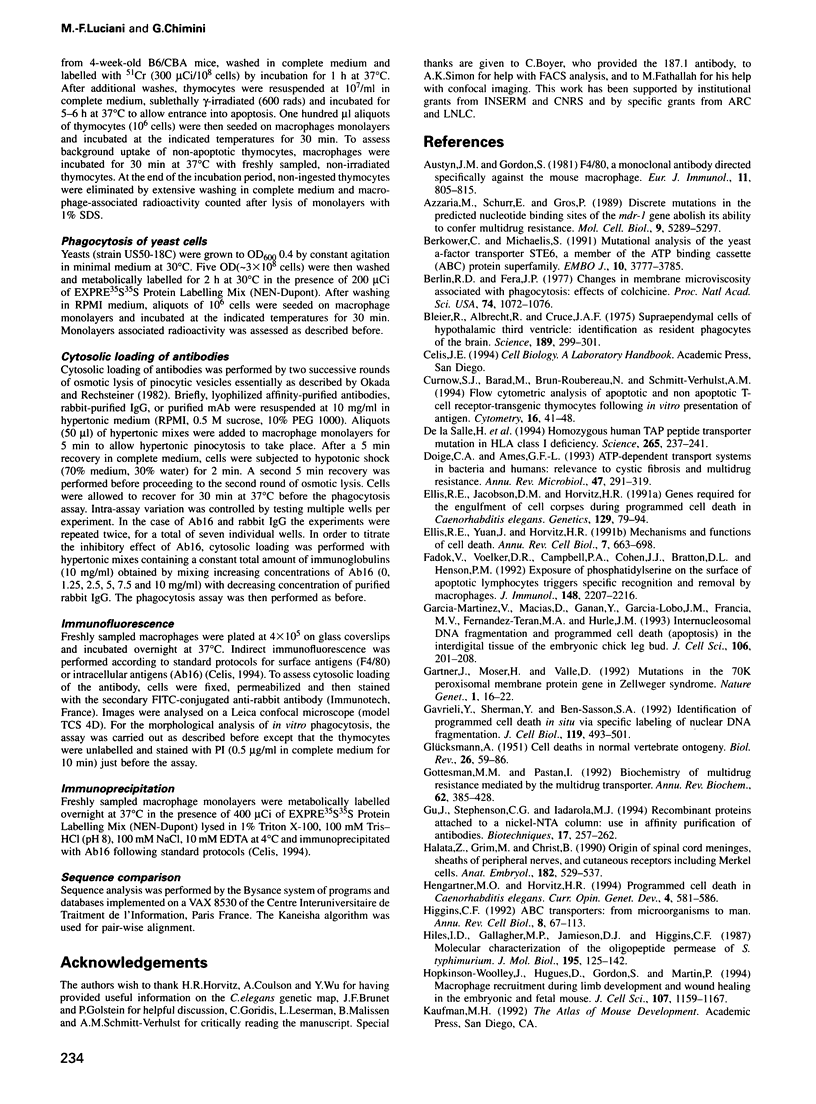
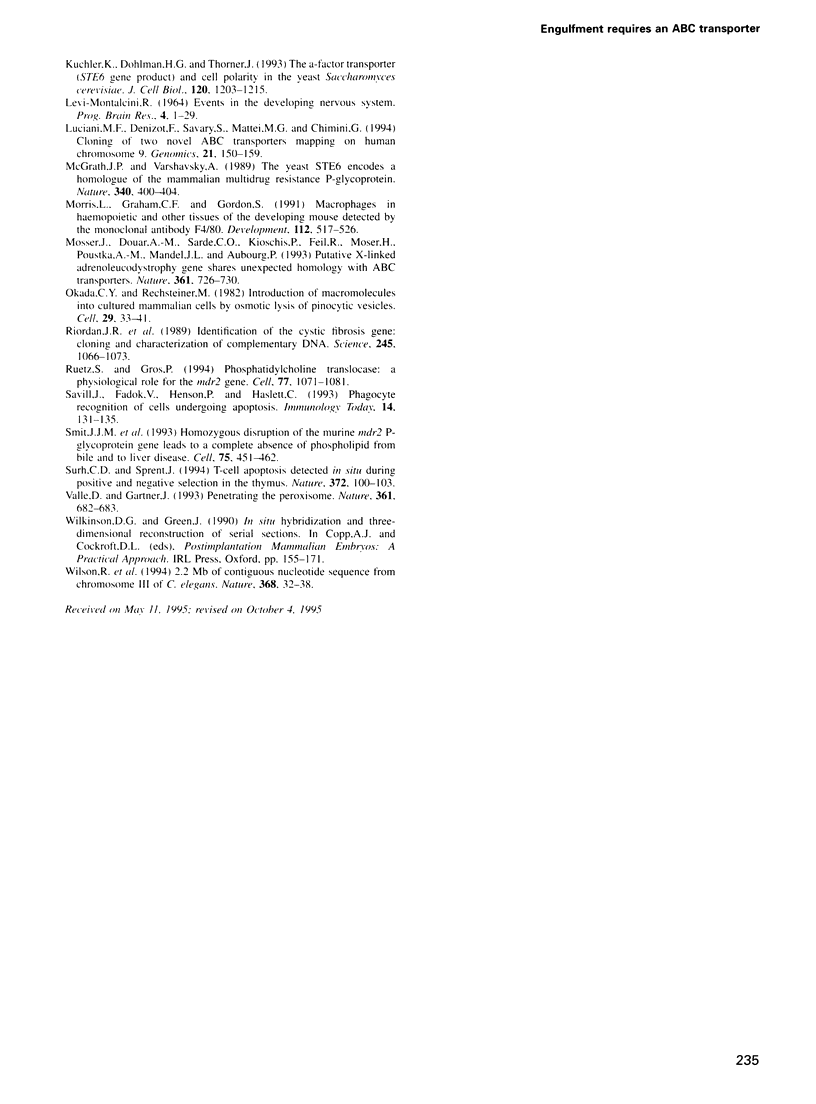
Images in this article
Selected References
These references are in PubMed. This may not be the complete list of references from this article.
- Austyn J. M., Gordon S. F4/80, a monoclonal antibody directed specifically against the mouse macrophage. Eur J Immunol. 1981 Oct;11(10):805–815. doi: 10.1002/eji.1830111013. [DOI] [PubMed] [Google Scholar]
- Azzaria M., Schurr E., Gros P. Discrete mutations introduced in the predicted nucleotide-binding sites of the mdr1 gene abolish its ability to confer multidrug resistance. Mol Cell Biol. 1989 Dec;9(12):5289–5297. doi: 10.1128/mcb.9.12.5289. [DOI] [PMC free article] [PubMed] [Google Scholar]
- Berkower C., Michaelis S. Mutational analysis of the yeast a-factor transporter STE6, a member of the ATP binding cassette (ABC) protein superfamily. EMBO J. 1991 Dec;10(12):3777–3785. doi: 10.1002/j.1460-2075.1991.tb04947.x. [DOI] [PMC free article] [PubMed] [Google Scholar]
- Berlin R. D., Fera J. P. Changes in membrane microviscosity associated with phagocytosis: effects of colchicine. Proc Natl Acad Sci U S A. 1977 Mar;74(3):1072–1076. doi: 10.1073/pnas.74.3.1072. [DOI] [PMC free article] [PubMed] [Google Scholar]
- Bleier R., Albrecht R., Cruce J. A. Supraependymal cells of hypothalamic third ventricle: identification as resident phagocytes of the brain. Science. 1975 Jul 25;189(4199):299–301. doi: 10.1126/science.1145204. [DOI] [PubMed] [Google Scholar]
- Curnow S. J., Barad M., Brun-Roubereau N., Schmitt-Verhulst A. M. Flow-cytometric analysis of apoptotic and nonapoptotic T-cell receptor-transgenic thymocytes following in vitro presentation of antigen. Cytometry. 1994 May 1;16(1):41–48. doi: 10.1002/cyto.990160107. [DOI] [PubMed] [Google Scholar]
- Doige C. A., Ames G. F. ATP-dependent transport systems in bacteria and humans: relevance to cystic fibrosis and multidrug resistance. Annu Rev Microbiol. 1993;47:291–319. doi: 10.1146/annurev.mi.47.100193.001451. [DOI] [PubMed] [Google Scholar]
- Ellis R. E., Jacobson D. M., Horvitz H. R. Genes required for the engulfment of cell corpses during programmed cell death in Caenorhabditis elegans. Genetics. 1991 Sep;129(1):79–94. doi: 10.1093/genetics/129.1.79. [DOI] [PMC free article] [PubMed] [Google Scholar]
- Ellis R. E., Yuan J. Y., Horvitz H. R. Mechanisms and functions of cell death. Annu Rev Cell Biol. 1991;7:663–698. doi: 10.1146/annurev.cb.07.110191.003311. [DOI] [PubMed] [Google Scholar]
- Fadok V. A., Voelker D. R., Campbell P. A., Cohen J. J., Bratton D. L., Henson P. M. Exposure of phosphatidylserine on the surface of apoptotic lymphocytes triggers specific recognition and removal by macrophages. J Immunol. 1992 Apr 1;148(7):2207–2216. [PubMed] [Google Scholar]
- Garcia-Martinez V., Macias D., Gañan Y., Garcia-Lobo J. M., Francia M. V., Fernandez-Teran M. A., Hurle J. M. Internucleosomal DNA fragmentation and programmed cell death (apoptosis) in the interdigital tissue of the embryonic chick leg bud. J Cell Sci. 1993 Sep;106(Pt 1):201–208. doi: 10.1242/jcs.106.1.201. [DOI] [PubMed] [Google Scholar]
- Gavrieli Y., Sherman Y., Ben-Sasson S. A. Identification of programmed cell death in situ via specific labeling of nuclear DNA fragmentation. J Cell Biol. 1992 Nov;119(3):493–501. doi: 10.1083/jcb.119.3.493. [DOI] [PMC free article] [PubMed] [Google Scholar]
- Gottesman M. M., Pastan I. Biochemistry of multidrug resistance mediated by the multidrug transporter. Annu Rev Biochem. 1993;62:385–427. doi: 10.1146/annurev.bi.62.070193.002125. [DOI] [PubMed] [Google Scholar]
- Gu J., Stephenson C. G., Iadarola M. J. Recombinant proteins attached to a nickel-NTA column: use in affinity purification of antibodies. Biotechniques. 1994 Aug;17(2):257–262. [PubMed] [Google Scholar]
- Gärtner J., Moser H., Valle D. Mutations in the 70K peroxisomal membrane protein gene in Zellweger syndrome. Nat Genet. 1992 Apr;1(1):16–23. doi: 10.1038/ng0492-16. [DOI] [PubMed] [Google Scholar]
- Halata Z., Grim M., Christ B. Origin of spinal cord meninges, sheaths of peripheral nerves, and cutaneous receptors including Merkel cells. An experimental and ultrastructural study with avian chimeras. Anat Embryol (Berl) 1990;182(6):529–537. doi: 10.1007/BF00186459. [DOI] [PubMed] [Google Scholar]
- Hengartner M. O., Horvitz H. R. Programmed cell death in Caenorhabditis elegans. Curr Opin Genet Dev. 1994 Aug;4(4):581–586. doi: 10.1016/0959-437x(94)90076-f. [DOI] [PubMed] [Google Scholar]
- Higgins C. F. ABC transporters: from microorganisms to man. Annu Rev Cell Biol. 1992;8:67–113. doi: 10.1146/annurev.cb.08.110192.000435. [DOI] [PubMed] [Google Scholar]
- Hiles I. D., Gallagher M. P., Jamieson D. J., Higgins C. F. Molecular characterization of the oligopeptide permease of Salmonella typhimurium. J Mol Biol. 1987 May 5;195(1):125–142. doi: 10.1016/0022-2836(87)90332-9. [DOI] [PubMed] [Google Scholar]
- Hopkinson-Woolley J., Hughes D., Gordon S., Martin P. Macrophage recruitment during limb development and wound healing in the embryonic and foetal mouse. J Cell Sci. 1994 May;107(Pt 5):1159–1167. doi: 10.1242/jcs.107.5.1159. [DOI] [PubMed] [Google Scholar]
- Kuchler K., Dohlman H. G., Thorner J. The a-factor transporter (STE6 gene product) and cell polarity in the yeast Saccharomyces cerevisiae. J Cell Biol. 1993 Mar;120(5):1203–1215. doi: 10.1083/jcb.120.5.1203. [DOI] [PMC free article] [PubMed] [Google Scholar]
- Luciani M. F., Denizot F., Savary S., Mattei M. G., Chimini G. Cloning of two novel ABC transporters mapping on human chromosome 9. Genomics. 1994 May 1;21(1):150–159. doi: 10.1006/geno.1994.1237. [DOI] [PubMed] [Google Scholar]
- McGrath J. P., Varshavsky A. The yeast STE6 gene encodes a homologue of the mammalian multidrug resistance P-glycoprotein. Nature. 1989 Aug 3;340(6232):400–404. doi: 10.1038/340400a0. [DOI] [PubMed] [Google Scholar]
- Morris L., Graham C. F., Gordon S. Macrophages in haemopoietic and other tissues of the developing mouse detected by the monoclonal antibody F4/80. Development. 1991 Jun;112(2):517–526. doi: 10.1242/dev.112.2.517. [DOI] [PubMed] [Google Scholar]
- Mosser J., Douar A. M., Sarde C. O., Kioschis P., Feil R., Moser H., Poustka A. M., Mandel J. L., Aubourg P. Putative X-linked adrenoleukodystrophy gene shares unexpected homology with ABC transporters. Nature. 1993 Feb 25;361(6414):726–730. doi: 10.1038/361726a0. [DOI] [PubMed] [Google Scholar]
- Okada C. Y., Rechsteiner M. Introduction of macromolecules into cultured mammalian cells by osmotic lysis of pinocytic vesicles. Cell. 1982 May;29(1):33–41. doi: 10.1016/0092-8674(82)90087-3. [DOI] [PubMed] [Google Scholar]
- Riordan J. R., Rommens J. M., Kerem B., Alon N., Rozmahel R., Grzelczak Z., Zielenski J., Lok S., Plavsic N., Chou J. L. Identification of the cystic fibrosis gene: cloning and characterization of complementary DNA. Science. 1989 Sep 8;245(4922):1066–1073. doi: 10.1126/science.2475911. [DOI] [PubMed] [Google Scholar]
- Ruetz S., Gros P. Phosphatidylcholine translocase: a physiological role for the mdr2 gene. Cell. 1994 Jul 1;77(7):1071–1081. doi: 10.1016/0092-8674(94)90446-4. [DOI] [PubMed] [Google Scholar]
- Savill J., Fadok V., Henson P., Haslett C. Phagocyte recognition of cells undergoing apoptosis. Immunol Today. 1993 Mar;14(3):131–136. doi: 10.1016/0167-5699(93)90215-7. [DOI] [PubMed] [Google Scholar]
- Smit J. J., Schinkel A. H., Oude Elferink R. P., Groen A. K., Wagenaar E., van Deemter L., Mol C. A., Ottenhoff R., van der Lugt N. M., van Roon M. A. Homozygous disruption of the murine mdr2 P-glycoprotein gene leads to a complete absence of phospholipid from bile and to liver disease. Cell. 1993 Nov 5;75(3):451–462. doi: 10.1016/0092-8674(93)90380-9. [DOI] [PubMed] [Google Scholar]
- Surh C. D., Sprent J. T-cell apoptosis detected in situ during positive and negative selection in the thymus. Nature. 1994 Nov 3;372(6501):100–103. doi: 10.1038/372100a0. [DOI] [PubMed] [Google Scholar]
- Valle D., Gärtner J. Human genetics. Penetrating the peroxisome. Nature. 1993 Feb 25;361(6414):682–683. doi: 10.1038/361682a0. [DOI] [PubMed] [Google Scholar]
- Wilson R., Ainscough R., Anderson K., Baynes C., Berks M., Bonfield J., Burton J., Connell M., Copsey T., Cooper J. 2.2 Mb of contiguous nucleotide sequence from chromosome III of C. elegans. Nature. 1994 Mar 3;368(6466):32–38. doi: 10.1038/368032a0. [DOI] [PubMed] [Google Scholar]
- de la Salle H., Hanau D., Fricker D., Urlacher A., Kelly A., Salamero J., Powis S. H., Donato L., Bausinger H., Laforet M. Homozygous human TAP peptide transporter mutation in HLA class I deficiency. Science. 1994 Jul 8;265(5169):237–241. doi: 10.1126/science.7517574. [DOI] [PubMed] [Google Scholar]




